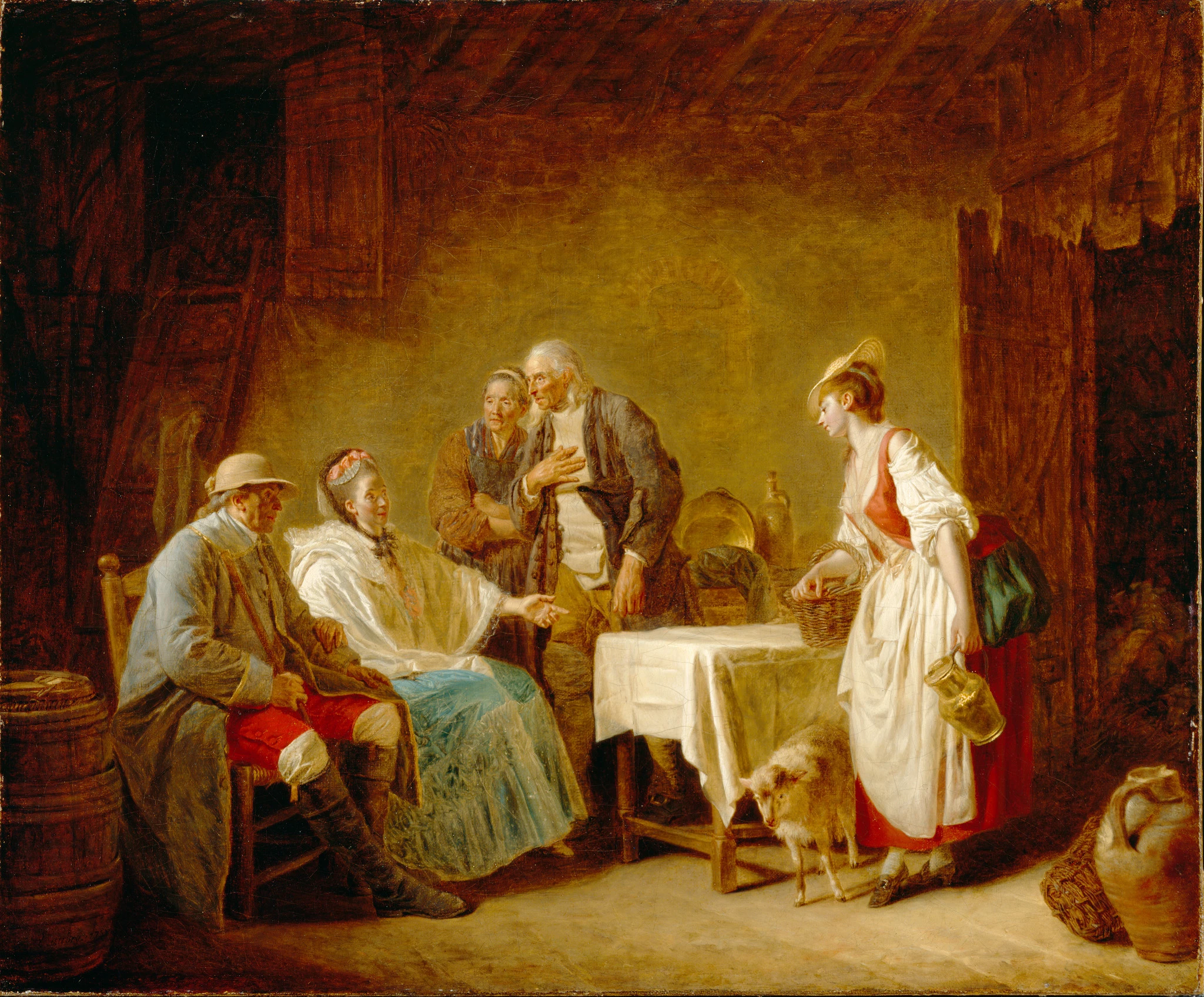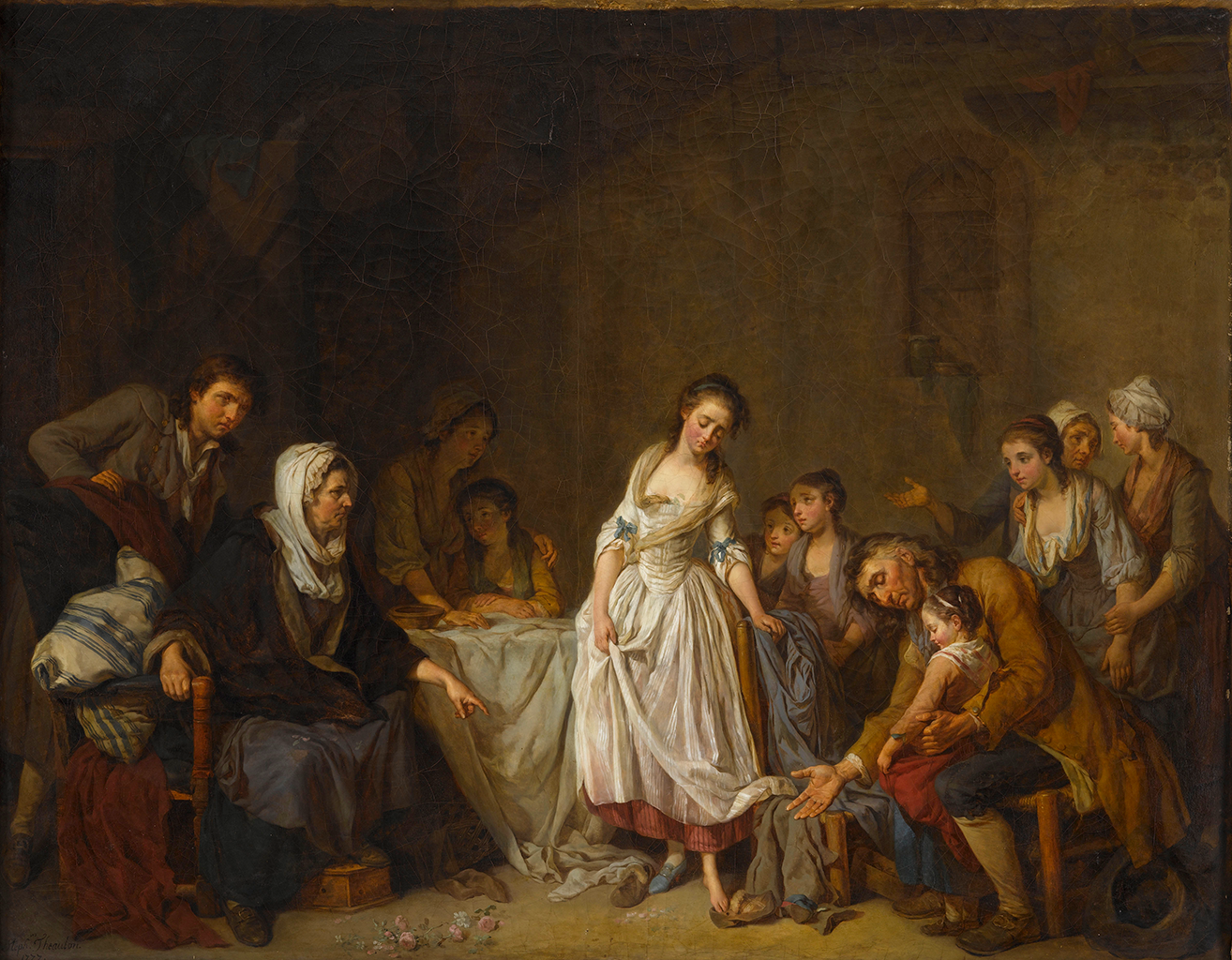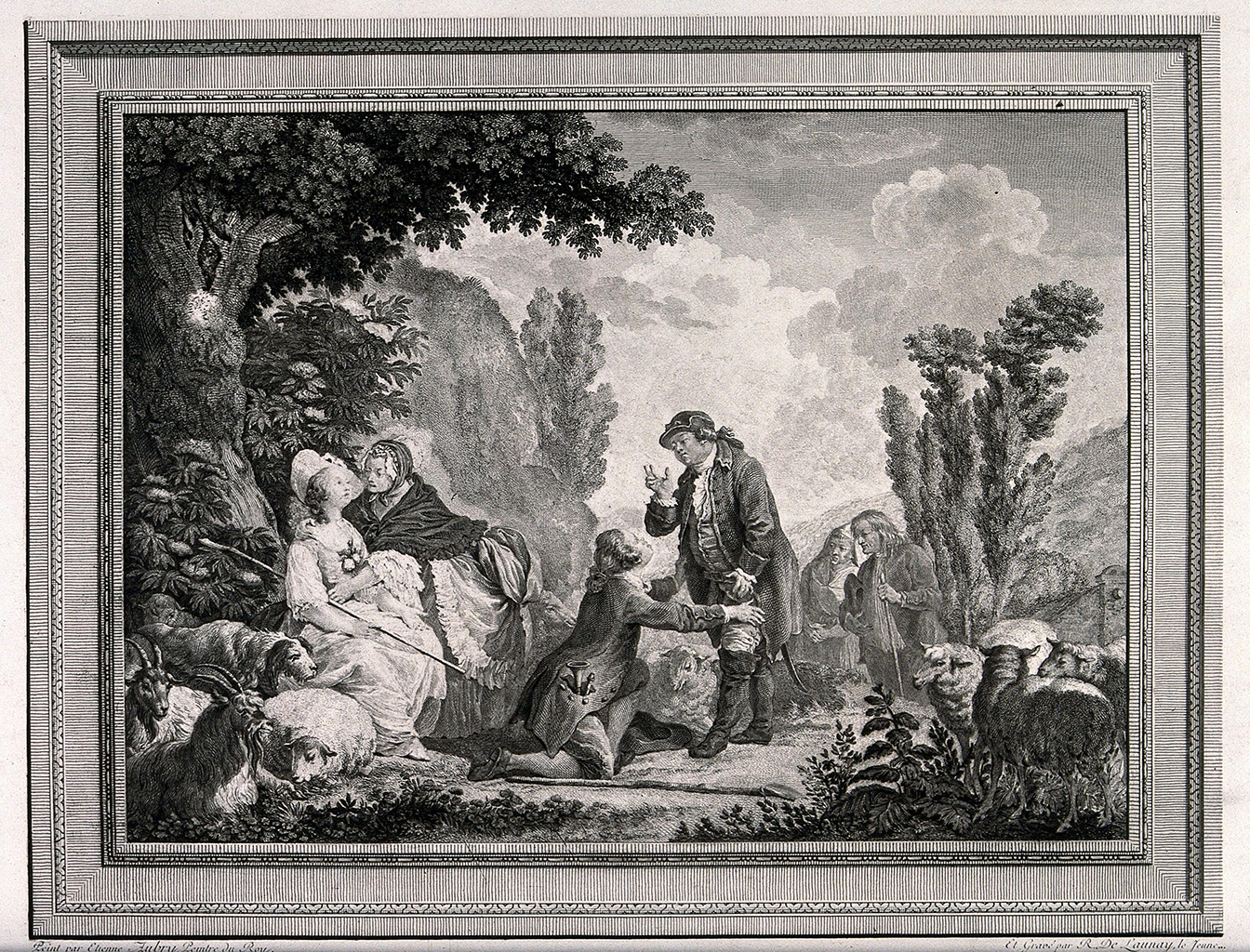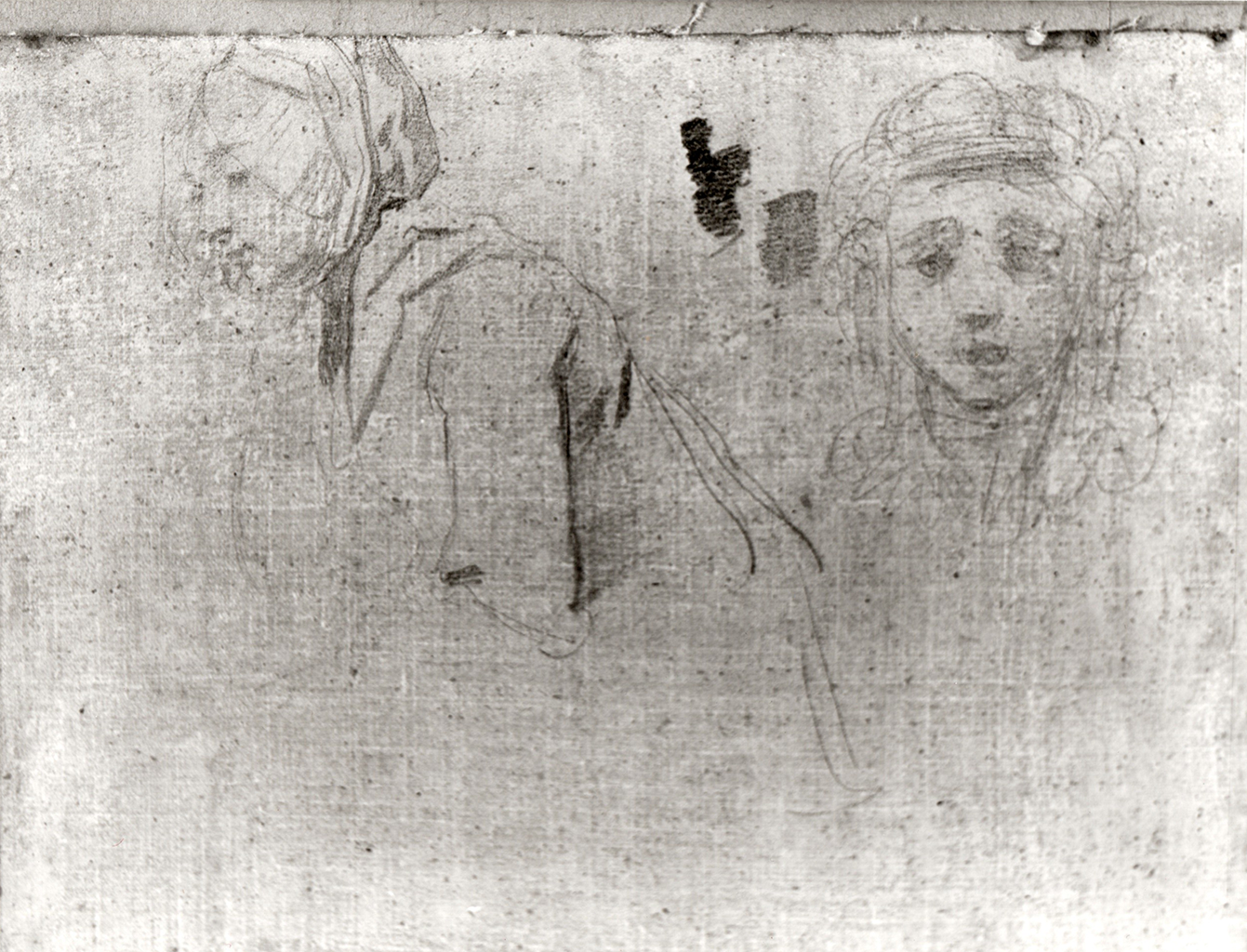![]()
Etienne Aubry, Scene from “Lucile,” ca. 1775
| Artist | Etienne Aubry, French, 1745–1781 |
| Title | Scene from “Lucile” |
| Object Date | ca. 1775 |
| Alternate and Variant Titles | Le Fils Fautif, The Offending Son |
| Medium | Oil on paper, mounted on canvas |
| Dimensions (Unframed) | 13 5/16 × 18 5/16 in. (33.87 × 46.57 cm) |
| Credit Line | The Nelson-Atkins Museum of Art. Gift of Allan Katz and Nancy Cohn, 2022.5 |
Catalogue Entry
Citation
Chicago:
Glynnis Napier Stevenson, “Etienne Aubry, Scene from “Lucile”, ca. 1775,” catalogue entry in French Paintings and Pastels, 1600–1945: The Collections of the Nelson-Atkins Museum of Art, ed. Aimee Marcereau DeGalan (Kansas City: The Nelson-Atkins Museum of Art, 2024), https://doi.org/10.37764/78973.5.303.5407.
MLA:
Stevenson, Glynnis Napier. “Etienne Aubry, Scene from “Lucile”, ca. 1775,” catalogue entry. French Paintings and Pastels, 1600–1945: The Collections of The Nelson-Atkins Museum of Art, edited by Aimee Marcereau DeGalan, Nelson-Atkins Museum of Art, 2024. doi: 10.37764/78973.5.303.5407.
This oil sketch by Etienne Aubry of a pair of young lovers in distress is by one of the eighteenth century’s leading genre painters. However, questions surrounding its attribution have intrigued scholars from the moment it appeared on the market in 1985. There has been little scholarship on Aubry overall, making any definite conclusions difficult.1A Sorbonne dissertation, which remains difficult to access, sought to create the first catalogue raisonné of Aubry’s works. See Caroline Fossey, “Etienne Aubry: Peintre du Roi, 1745–1781” (PhD diss., Université de Paris I Panthéon-Sorbonne, 1989). Other Aubry studies have analyzed his take on the socially important issue of wet nursing, which was under debate during the French Enlightenment and is also at issue in Marmontel’s Lucile. See Patricia R. Ivinski et al., Farewell to the Wet Nurse: Etienne Aubry and Images of Breast-Feeding in Eighteenth-Century France, exh. cat. (Williamstown, MA: Sterling and Francine Clark Art Institute, 1998). Aubry is considered a genre painter for his interest in moralizing dramas. See Richard Rand, “The Intimate Interior in Eighteenth-Century French Genre Painting,” Antiques Magazine 152, no. 3 (September 1997): 324; Emma Barker, “Putting the Viewer in the Frame: Greuze as Sentimentalist,” Studies in the History of Art 72 (2007): 105–27; and Kristel Smentek, “Sex, Sentiment, and Speculation: The Market for Genre Prints on the Eve of the French Revolution,” Studies in the History of Art 72 (2007): 220–43. At one point, a label attached to a former frame suggested that this was the work of Aubry’s contemporary Etienne Théaulon (1730–1780), though there was little to support this assertion.2One Hundred Drawings and Watercolours Dated from the 16th Century to the Present Day (London: Stephen Ongpin Fine Art and Guy Peppiatt Fine Art, 2013), 10. Ahead of the Nelson-Atkins’s acquisition of the painting, the dealer Derek Johns, who had once purchased it, affirmed that the late Greuze scholar Anita Brookner had attributed the painting to Aubry.3Derek Johns, London, to Aimee Marcereau DeGalan, NAMA, January 21, 2022, NAMA curatorial file. Johns purchased the sketch jointly with his business partners Philip Harari and Colnaghi Gallery in 1985. Brookner was an expert in the work of Jean-Baptiste Greuze, the best-known genre painter of his era. Her knowledge of Greuze extended to a keen understanding of Aubry’s œuvre as well. Johns also drew the museum’s attention to two pencil sketches on the verso (Fig. 1), which are no longer visible after relininglining: A procedure used to reinforce a weakened canvas that involves adhering a second fabric support using adhesive, most often a glue-paste mixture, wax, or synthetic adhesive..4Johns to Marcereau DeGalan, January 21, 2022. The relining may have been done while the painting was with Johns between 1985 and 1996. These drawings point to the centrality of the young woman’s emotions and reflect the artist’s desire to perfect his composition. The painted sketch on the front of the canvas softens the firm lines of the pencil drawings, heightening the drama and sentimentality of the work in a way that sharp edges could not. The drawings also reveal the extent to which Aubry developed this subject, even if he never produced a related finished canvas for the prestigious SalonSalon, the: Exhibitions organized by the French Royal Academy of Painting and Sculpture (Académie Royale de Peinture et de Sculpture) and its successor the Academy of Fine Arts (Académie des Beaux Arts), which took place in Paris from 1667 onward..5Aubry, who died at age thirty-six, had a very short Salon career, spanning only the 1770s.
Lucile opens with the titular character excitedly readying for her wedding day to her fiancé Dorval in her father Timante’s home. Chrisman-Campbell has confirmed the wedding-centric aspect of the Nelson-Atkins picture, noting the figure of the marchande de modesmarchande de modes: A vendor who supplied women’s fashion accessories, such as trimmings to decorate caps and shawls. in the doorway, easy to identify by the bandbox under her arm.8Chrisman-Campbell to Stevenson, March 8, 2023. The translation “milliner,” which in modern times suggests hat-making, does not do this occupation justice. In the eighteenth century, a marchande de modes made bespoke gowns even more spectacular with individually selected gloves, lace, and other trimmings, as well as hats. This line of work was immortalized in many contemporaneous paintings and prints, most famously in François Boucher (1703–1770)’s The Milliner (Fig. 2). In Boucher’s work, the marchande sits rather ignominiously on the floor as her well-heeled client looks through the available accessories in the bandbox.

The marchande is being rushed out of the room after Lucile’s pre-nuptial preparations are interrupted by Blaise, the widower of Lucile’s wet nurse, who reveals the shocking family secret that Lucile was switched at birth.10David Charlton, “Lucile,” Grove Music Online, December 1, 1992, https://doi.org/10.1093/gmo/9781561592630.article.O005009. The practice of sending infants to nurses in the countryside was a subject of debate during the Enlightenment. It inspired treatises by thinkers like Jean-Jacques Rousseau (1712–1778) and canvases like Aubry’s pro–wet-nurse composition, First Lesson of Fraternal Friendship (32-167) and Jean-Baptiste Greuze’s The Nursemaids (31-61), which shows a more negative association with this practice.11For an in-depth look at the issue of wet nursing in eighteenth-century French society and painting, see Ivinski et al., Farewell to the Wet Nurse. As the wet nurse’s dishonesty sets in motion the comedy of errors in Lucile, this play offers another, more lighthearted, take on the issue. To emphasize the point that this wedding day has not started in the best way, the earthenware tureen in the middle of the table at center is ajar. Broken crockery was a common metaphor for sexual impropriety in eighteenth-century genre scenes, but this piece’s lid is simply askew, and the viewer knows that all is easily put right.12P. J. Vinken, “Some Observations on the Symbolism of the Broken Pot in Art and Literature,” American Imago 15, no. 2 (1958): 149–74.



Aubry painted two scenes that allow the status of the Fonroses to contrast with that of Adélaïde, her family, and their rustic home. For example, the elderly woman in both compositions, probably the maid Julie, wears a shawl and a bonnet much like Countess Fonrose’s costume, though Julie’s shawl is black, not white, and her bonnet does not have fine silk ribbons like the Countess’s does. Lucile, like The Shepherdess of the Alps, is a class-mixing comedy that lightly ribs the elite for their adherence to superficial rules of dress and status. Lucile’s fiancé, Dorval, wears several expensive items, like a gray laced coat and red heels, but collapses at the first sign of difficulty.15Chrisman-Campbell identifies the chicness of the young man’s clothing but also emphasizes that none of it goes together. See Chrisman-Campbell to Stevenson, March 8, 2023. Perhaps this is meant to show his immaturity or the limitations of a theater’s costume department. The heroines of both plays prove themselves worthy brides, perhaps better than their hapless suitors deserve, via the contents of their characters.
Notes:
-
A Sorbonne dissertation, which remains difficult to access, sought to create the first catalogue raisonné of Aubry’s works. See Caroline Fossey, “Etienne Aubry: Peintre du Roi, 1745–1781” (PhD diss., Université de Paris I Panthéon-Sorbonne, 1989). Other Aubry studies have analyzed his take on the socially important issue of wet nursing, which was under debate during the French Enlightenment and is also at issue in Marmontel’s Lucile. See Patricia R. Ivinski et al., Farewell to the Wet Nurse: Etienne Aubry and Images of Breast-Feeding in Eighteenth-Century France, exh. cat. (Williamstown, MA: Sterling and Francine Clark Art Institute, 1998). Aubry is considered a genre painter for his interest in moralizing dramas. See Richard Rand, “The Intimate Interior in Eighteenth-Century French Genre Painting,” Antiques Magazine 152, no. 3 (September 1997): 324; Emma Barker, “Putting the Viewer in the Frame: Greuze as Sentimentalist,” Studies in the History of Art 72 (2007): 105–27; and Kristel Smentek, “Sex, Sentiment, and Speculation: The Market for Genre Prints on the Eve of the French Revolution,” Studies in the History of Art 72 (2007): 220–43.
-
One Hundred Drawings and Watercolours Dated from the 16th Century to the Present Day (London: Stephen Ongpin Fine Art and Guy Peppiatt Fine Art, 2013), 10.
-
Derek Johns, London, to Aimee Marcereau DeGalan, NAMA, January 21, 2022, NAMA curatorial file. Johns purchased the sketch jointly with his business partners Philip Harari and Colnaghi Gallery in 1985. Brookner was an expert in the work of Jean-Baptiste Greuze, the best-known genre painter of his era. Her knowledge of Greuze extended to a keen understanding of Aubry’s œuvre as well.
-
Johns to Marcereau DeGalan, January 21, 2022. The relining may have been done while the painting was with Johns between 1985 and 1996.
-
Aubry, who died at age thirty-six, had a very short Salon career, spanning only the 1770s.
-
Kimberly Chrisman-Campbell to Glynnis Napier Stevenson, NAMA, March 8, 2023, NAMA curatorial file.
-
Jean-François Marmontel and André-Ernest-Modeste Grétry, Lucile: Comédie en un acte, melée d’ariettes, représentée pour la première fois par les Comédiens italiens ordinaires du roi, le 5 janvier 1769 (Besançon: Chez Fantet, 1769).
-
Chrisman-Campbell to Stevenson, March 8, 2023.
-
Kimberly Chrisman-Campbell, Fashion Victims: Dress at the Court of Louis XVI and Marie-Antoinette (New Haven: Yale University Press, 2015), 78, 80.
-
David Charlton, “Lucile,” Grove Music Online, December 1, 1992, https://doi.org/10.1093/gmo/9781561592630.article.O005009.
-
For an in-depth look at the issue of wet nursing in eighteenth-century French society and painting, see Ivinski et al., Farewell to the Wet Nurse.
-
P. J. Vinken, “Some Observations on the Symbolism of the Broken Pot in Art and Literature,” American Imago 15, no. 2 (1958): 149–74.
-
Aubry regularly populates his canvases with recycled characters. The little boy with the drum, who does not appear in the Lucile cast list, nonetheless appears in the Nelson-Atkins picture and another Aubry of 1775, Paternal Love, at the Barber Institute of Fine Arts, Birmingham, UK.
-
Jean-François Marmontel, The Shepherdess of the Alps: A Very Interesting, Pathetic, and Moral History (Glasgow: The Booksellers, 1840), 4.
-
Chrisman-Campbell identifies the chicness of the young man’s clothing but also emphasizes that none of it goes together. See Chrisman-Campbell to Stevenson, March 8, 2023. Perhaps this is meant to show his immaturity or the limitations of a theater’s costume department.
Technical Entry
Technical entry forthcoming.
Documentation
Citation
Chicago:
Glynnis Napier Stevenson, “Etienne Aubry, Scene from “Lucile”, ca. 1775,” documentation in French Paintings and Pastels, 1600–1945: The Collections of The Nelson-Atkins Museum of Art, ed. Aimee Marcereau DeGalan (Kansas City, MO: The Nelson-Atkins Museum of Art, 2024), https://doi.org/10.37764/78973.5.303.4033.
MLA:
Stevenson, Glynnis Napier. “Etienne Aubry, Scene from “Lucile”, ca. 1775,” documentation. French Paintings and Pastels, 1600–1945: The Collections of The Nelson-Atkins Museum of Art, edited by Aimee Marcereau DeGalan, The Nelson-Atkins Museum of Art, 2024. doi: 10.37764/78973.5.303.4033.
Provenance
Citation
Chicago:
Glynnis Napier Stevenson, “Etienne Aubry, Scene from “Lucile”, ca. 1775,” documentation in French Paintings and Pastels, 1600–1945: The Collections of The Nelson-Atkins Museum of Art, ed. Aimee Marcereau DeGalan (Kansas City, MO: The Nelson-Atkins Museum of Art, 2024), https://doi.org/10.37764/78973.5.303.4033.
MLA:
Stevenson, Glynnis Napier. “Etienne Aubry, Scene from “Lucile”, ca. 1775,” documentation. French Paintings and Pastels, 1600–1945: The Collections of The Nelson-Atkins Museum of Art, edited by Aimee Marcereau DeGalan, The Nelson-Atkins Museum of Art, 2024. doi: 10.37764/78973.5.303.4033.
Private collection, France;
Purchased from Ader Picard Tajan, Hôtel Drouot, Paris, as by François Guérin, by Philip Harari and Derek Johns, Ltd., London, in half shares with P. and D. Colnaghi, London, 1985–May 10, 1996 [1];
Purchased from Colnaghi by Allan J. Katz (b. 1947) and Nancy E. Cohn (b. 1947), Kansas City, MO, May 10, 1996–February 24, 2022 [2];
Given by Allan Katz and Nancy Cohn to The Nelson-Atkins Museum of Art, Kansas City, MO, 2022.
Notes:
[1] See email from Derek Johns, Derek Johns Fine Art, to Aimee Marcereau DeGalan, NAMA, January 21, 2022, NAMA curatorial files. Johns acquired the painting from a sale in Paris (no catalogue/date), although he recalled that it was 1985. At the time, the painting was attributed to François Guerin. The late Greuze scholar, Anita Brookner (Courtauld), subsequently attributed the picture to Aubry.
Stephen Ongpin, who worked for P. and D. Colnaghi, New York, from 1986 to 1996, and then at the firm’s London gallery from 1996 to 2006, remembered that the sale was at the Hôtel Drouot in Paris and operated by the auctioneers Ader-Picard-Tajan, although he thought it was between 1993 and 1995. See email from Ongpin to Aimee Marcereau DeGalan, NAMA, December 15, 2021, NAMA curatorial files.
[2] Cohn and Katz offered the painting for sale at Old Master Paintings Part II, Christie’s, New York, January 31, 2013, lot 286, as by Etienne Aubry, Le Fils Fautif; and at Old Master Drawings, Sotheby’s, New York, January 30, 2019, lot 74, as by Etienne Aubry, The Offending Son (Le Fils Fautif), but it failed to sell both times.
Related Works
Citation
Chicago:
Glynnis Napier Stevenson, “Etienne Aubry, Scene from “Lucile”, ca. 1775,” documentation in French Paintings and Pastels, 1600–1945: The Collections of The Nelson-Atkins Museum of Art, ed. Aimee Marcereau DeGalan (Kansas City, MO: The Nelson-Atkins Museum of Art, 2024), https://doi.org/10.37764/78973.5.303.4033.
MLA:
Stevenson, Glynnis Napier. “Etienne Aubry, Scene from “Lucile”, ca. 1775,” documentation. French Paintings and Pastels, 1600–1945: The Collections of The Nelson-Atkins Museum of Art, edited by Aimee Marcereau DeGalan, The Nelson-Atkins Museum of Art, 2024. doi: 10.37764/78973.5.303.4033.
Étienne Aubry, The Shepherdess of the Alps, 1775, oil on canvas, 20 x 20 1/2 in. (50.8 x 62.2 cm.), Detroit Institute of Arts, Founders Society Purchase with funds from Mr. and Mrs. Edgar B. Whitcomb, 48.12.
Robert Delaunay, after Étienne Aubry, An episode in “Sheperdess of the Alps” by Jean-François Marmontel: Fonrose disguised as a shepherd begs forgiveness from his father M. de Fonrose, while the seated goatherd Adelaide de Sevile is embraced by Madame de Fonrose, 1786, etching, 12 11/16 x 13 7/8 in. (32.2 x 35.2 cm), Wellcome Collection, London, 28851i.
Exhibitions
Citation
Chicago:
Glynnis Napier Stevenson, “Etienne Aubry, Scene from “Lucile”, ca. 1775,” documentation in French Paintings and Pastels, 1600–1945: The Collections of The Nelson-Atkins Museum of Art, ed. Aimee Marcereau DeGalan (Kansas City, MO: The Nelson-Atkins Museum of Art, 2024), https://doi.org/10.37764/78973.5.303.4033.
MLA:
Stevenson, Glynnis Napier. “Etienne Aubry, Scene from “Lucile”, ca. 1775,” documentation. French Paintings and Pastels, 1600–1945: The Collections of The Nelson-Atkins Museum of Art, edited by Aimee Marcereau DeGalan, The Nelson-Atkins Museum of Art, 2024. doi: 10.37764/78973.5.303.4033.
One Hundred Drawings and Watercolours dated from the 16th century to the present day, Stephen Ongpin Fine Art, Riverwide House, London, Winter 2013–2014, no. 8, as by Etienne Aubry, The Offending Son (Le fils fautif).
References
Citation
Chicago:
Glynnis Napier Stevenson, “Etienne Aubry, Scene from “Lucile”, ca. 1775,” documentation in French Paintings and Pastels, 1600–1945: The Collections of The Nelson-Atkins Museum of Art, ed. Aimee Marcereau DeGalan (Kansas City, MO: The Nelson-Atkins Museum of Art, 2024), https://doi.org/10.37764/78973.5.303.4033.
MLA:
Stevenson, Glynnis Napier. “Etienne Aubry, Scene from “Lucile”, ca. 1775,” documentation. French Paintings and Pastels, 1600–1945: The Collections of The Nelson-Atkins Museum of Art, edited by Aimee Marcereau DeGalan, The Nelson-Atkins Museum of Art, 2024. doi: 10.37764/78973.5.303.4033.
One Hundred Drawings and Watercolours dated from the 16th century to the present day, exh. cat. (London: Stephen Ongpin Fine Art and Guy Peppiatt Fine Art, Ltd., Winter 2013), 10, (repro.), as by Etienne Aubry, The Offending Son (Le fils fautif).
Old Master Paintings Part II: Property from the Château de Dampierre, France; Property from the collection of Charles and Nonie de Limur, San Francisco; Property from the collection of Nancy Cohn and Allan Katz (New York: Christie’s, January 31, 2013), 80, as by Étienne Aubry, Le fils fautif.
Old Master Drawings (New York: Sotheby’s, January 30, 2019), l18, as by Étienne Aubry, The Offending Son (Le fils fautif).
